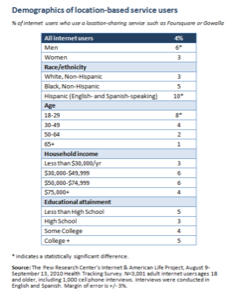Pew Internet & American Life Project is out with its first report on the use of “geosocial” services – that is, mobile location-based services that allow users to “check in” to a particular venue and see which of their friends are nearby. According to the researchers’ findings, only 4% of online adults are using a location-based app like Foursquare or Gowalla on their mobile phones. And on any given day, only 1% of Internet users have checked in.

Remember These Stats?
Does this news sound familiar? It should – it’s the latest in a long line of independent reports finding the exact same thing: this “check-in” craze has not gone mainstream.

In case you missed the earlier news, here’s a wrap-up:
- In July, Forrester found that only 4% of U.S. online adults used location-based services.
- In August, Harris Interactive surveyed 2,000 U.S. adults and found that only 7% of men and 3% of women “showed interest” in location-based services.
- In September, mobile media provider Myxer released a report which found that only 11% of mobile users are participating in location-based networking.
Lest you thought that the trend was on the rise, Pew’s data is a reality-check (assuming you buy it, of course). Like Forrester discovered earlier this year, Pew also found that usage of these check-in geosocial services is at 4% of U.S. online adults.
[Side note: We appreciate that Pew has given the check-in apps a new name: “geosocial” services. Forrester’s report looked mainly at check-in apps, too, but insisted upon calling them “location-based services.” That’s confusing since technically, “location-based services” include a phone’s Maps application or other commonly used apps that access your location to deliver things like local news, current movie showtimes, nearby attractions, etc. There’s an increasing need to differentiate between an app used for checking in and an app that simply is location-aware.]Check-In Users: More Adults, Males, Hispanics
Pew’s research data did uncover some other interesting findings as well. It confirmed that the demographic most involved with check-in applications is those aged 18-29 (8% usage rate), a group that’s more adult than teen. That’s likely due to the fact that the majority of check-in apps still require a smartphone to work – a phone that’s often pricier than a high-school student or their parents can afford. To compare, Forrester found that 70% of check-in app users were 19-35.
The new report also confirms that these services are still more popular with men than with women: 6% of online men use a check-in app like Foursquare, compared with only 3% of women. Forrester also found that check-in users were predominantly male (80% were male). This tells us two things: one, that there are a still a good many women out there with safety and privacy concerns regarding these services and two, that fewer women see the value in using these apps.
And do you target those women? Coupons, deals, and bargains. That’s not a sexist statement – statistically, women are the bargain-hunters in the family. In Myxer’s study for example, 28% of women between 35 and 54 were interested in mobile marketing initiatives compared with only 22% of men.
Another item of interest: Hispanics use check-in apps significantly more than other groups, with 10% usage among online adults compared with 5% of blacks and 3% of whites.

Over-Hyped? Or Up-and-Coming?
Although this report may appear to be bad news for geosocial service providers, it’s important to note that just because check-in apps haven’t gone mainstream yet, that doesn’t mean they never will. Those who use check-in apps, while still the minority, are passionate about doing so. And even Forrester advised that marketers should take this quieter, ramping-up period as a time to experiment with the services.

As Pew mentioned in its report, there was a time when Twitter wasn’t all that popular either – in August 2008, only 6% of adults used Twitter. Over the course of the past two years, that number has grown to 24%. Check-in apps may soon see a similar trend.









